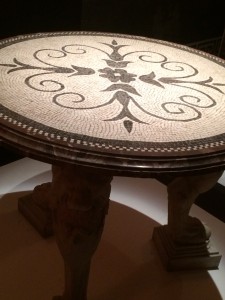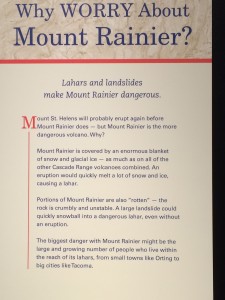
Today’s activity was to visit the Pompeii display downtown Seattle.
Pompeii was an ancient Italian city of 25,000,near Naples and the sea, which was destroyed when Mt Vesuvius, a volcano, erupted in AD 79, killing 20oo people and burying the city. I was intrigued by the “moderness” that was depicted. I think of the first century as very poor and villages like we often see in Bible pictures. Pompeii was not that way. In fact, in many ways, it looked like it just walked out of the last century. It was the seaport where the wealthy went to live and relax.
 Because the city was a mix of Roman and Greece cultures and architectures, they often had gods from both in their homes. These gods were given daily sacrifices mostly of food. This is a Mediterranean area and the people still eat the same as they did…many fruits and vegetables and some meats. Pompeii was known for its fish sauce.
Because the city was a mix of Roman and Greece cultures and architectures, they often had gods from both in their homes. These gods were given daily sacrifices mostly of food. This is a Mediterranean area and the people still eat the same as they did…many fruits and vegetables and some meats. Pompeii was known for its fish sauce. The courtyards were large and livable. They often would pull their couches out there in the evening and enjoy the cool air. This basin was set to catch rainwater and pipe it underground. They had extensive water systems to meet their needs.
The courtyards were large and livable. They often would pull their couches out there in the evening and enjoy the cool air. This basin was set to catch rainwater and pipe it underground. They had extensive water systems to meet their needs.

Because money was not an issue, their walls were decorated with frescos and boards like this

Each little tile in this is about the size of the end of my pinkie.

Marble was an easily acquired item, so was used extensively for floors, walls, and tabletops.

The town square was actually a long rectangle with stores, a gym, medical places and any other necessary buildings. It was also a meeting place and city business was conducted there. The “gym” was much like ours with men and women’s dressing areas, exercise area, swimming pool, saunas, massages, baths, and a cooling bath with which to end. They were a bit different because slaves bathed them and gave them massages.

Doesn’t this look like an ordinary kid today? This is a bust of Gaius Caesar at the age of 10.

Gladiators provided entertainment and this is one of the preserved hats.

I enjoyed these clay pots and bowls because we still use these types of things.

As for medicine, I’m not sure we have advanced a whole lot. Here we have a tweezers, scales, and a square.

When the mountain of fire and ashes descended on the city, the bodies were “frozen in time”. So when uncovered, plaster could be poured into the molds made by the lava and ash and used to recreate these bodies. They are so complete that one can tell the type of shoes they wore. Pliny was a survivor and 18 years old at the time. He watched from a distance what happened and later wrote his memories of that time. Pliny – I have added a link for you to read. Just double-click on red.

And I guess because we have the volcanic mountains within 50 miles of us, the curators didn’t want us to get to complacent, so they added this poster and had a display of emergency supplies and a back pack. However, the emergencies supplies would be handy no matter what the emergency – even a hurricane or fire.

 Because the city was a mix of Roman and Greece cultures and architectures, they often had gods from both in their homes. These gods were given daily sacrifices mostly of food. This is a Mediterranean area and the people still eat the same as they did…many fruits and vegetables and some meats. Pompeii was known for its fish sauce.
Because the city was a mix of Roman and Greece cultures and architectures, they often had gods from both in their homes. These gods were given daily sacrifices mostly of food. This is a Mediterranean area and the people still eat the same as they did…many fruits and vegetables and some meats. Pompeii was known for its fish sauce. The courtyards were large and livable. They often would pull their couches out there in the evening and enjoy the cool air. This basin was set to catch rainwater and pipe it underground. They had extensive water systems to meet their needs.
The courtyards were large and livable. They often would pull their couches out there in the evening and enjoy the cool air. This basin was set to catch rainwater and pipe it underground. They had extensive water systems to meet their needs.
Did you live here when Mt. St. Helens erupted? That was pretty amazing. Where was this exhibit? Sounds very interesting, and I’ve not seen anything advertising it, but then we’ve been gone a lot. Good post!
I’m going to try answering again. Yes I remember going to milk the cow and wondering about the white stuff all over
When I returned to the house, DH told me what had happened. As a child, dad would take us to the mountain to climb
the “dog tooth” which of course is no longer there.
I don’t know how long the exhibit will still be in Seattle at the science center, but it is definitely worth going to see
Now about the chickens, I honestly don’t know, but I think somewhere between 20-30.